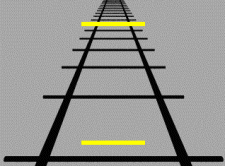What is psychology?
The scientific study of behavior and mental processes
What's the difference between a theory and hypothesis?
Theory = broad explanation that has usually been tested and supported already
Hypothesis = testable prediction
What nervous system response makes your heart race when you're scared?
What's the difference between sensation of perception?
Sensation = detecting stimuli
Perception = interpreting them.
What depth cues require both eyes and and which work with one eye?
(Both eyes) Binocular = retinal disparity, convergence.
(1 eye) Monocular = linear perspective, relative size, texture gradient.
How is structuralism different than functionalism?
Structuralism = breaks down conscious experience through introspection into basic elements, like sensations, images, and feelings -- "What makes up the STRUCTURE of consciousness"
Functionalism = studies the purpose/adaptive function of mental processes "What are the practical FUNCTIONS of mental processes"
What's the difference between a positive correlation and negative correlation?
Pos : As one variable increases, so does the other / as one variable decreases, so does the other (moving in same direction)
Neg : As one variable increases, the other decreases (moving in opposite direction)
What are some functions of the left vs right hemisphere?
Left: Language
Right: Facial recognition
You’re sitting in a quiet room. At first, you notice when a clock starts ticking — later, your friend slowly turns up the volume on the TV and you detect the change.
Which part of this example illustrates the absolute threshold?
Which part illustrates the just noticeable difference (JND)? Bonus: What is Weber's law?
Absolute threshold → noticing the clock ticking (detecting a stimulus at all -- absolute threshold is amount of stimulation needed to detect a stimulus 50% of the time).
JND → noticing the TV volume change (detecting a difference in intensity) (remember Weber's law! -- the difference is constant ratio)
What is an example of perceptual constancy?
Recognizing a door as rectangular even when it looks trapezoidal when open -- you know the door didn't change shape even though it looks that it is. (Keep in mind this applies with shape, size, color, etc.)
What was Wihelm Wundt known for?
The father of psychology, founder of structuralism -- studied what makes up consciousness using introspection
Why does correlation not equal causation?
Third variable or reverse causality problem
True or false : You only use one side of your brain? (Explain why or why not)
False -- if you have a corpus callosum, both sides of your brain are constantly working together and communicating
What are the components of signal detection theory?

What's the difference between top-down and bottom-up processing?
Bottom-up = data-driven (feature detection theory -- breaks down visual stimuli into basic features to figure out what a stimuli is -- seeing an unfamiliar fruit, and using features like color and texture to figure out what it is)
Top-down = expectation/experience-driven -- (The sntnce stll mkes snse) --Using experience to fill in the gaps
Match the founder with their respective school of thought
Freud, Watson & Skinner, Rogers & Maslow, Neisser
Psychoanalysis – Freud
Behaviorism – Watson & Skinner
Humanism – Rogers & Maslow
Cognitive revolution – Neisser
In a study testing sleep and memory, what are the IV and DV? What are some extraneous variables? How would you operationalize these variables?
IV: amount of sleep in hours
DV: memory performance on a memory test
Extraneous : Caffeine, stress, time of day etc.
What are the 4 main lobes of the brain and their functions?
Frontal : executive functioning / problem solving
Parietal -- sensory perception, spatial awarness
Temporal -- auditory processing, language comprehension
Occipital - vision
What is the 3 step process perceiving something (generally)?
Stimulus energy impacts sense receptors (like a light photon)
Sense organ (like eye) transduces stimulus energy into electrical code
Code is sent to cerebral cortex, resulting in psychological experience
Give an example of a visual illusion and explain why it happens in terms of depth or perception principles.
Ponzo illusion -- brain interprets the top line as being further away, and therefore larger, due to the context of the converging lines

What are some ways that psychology is being applied in a modern setting?
IO (industrial organizational) psych, consumer behavior, clinical psych
What research issue(s) occurs if someone were to only test one friend and generalize those "study findings" to others.
Low sample size, no randomization -- you can't generalize
A car accident patient shows multiple symptoms:
Difficulty with balance and fine motor coordination
Trouble regulating heart rate and breathing
Problems forming new memories
Increased aggression and emotional outbursts
Which brain regions (hindbrain, midbrain, and forebrain) might each symptom be linked to?
Balance and coordination → Cerebellum (hindbrain)
Heart rate and breathing → Medulla (hindbrain)
Memory formation → Hippocampus (forebrain)
Aggression/emotion → Amygdala (forebrain)
How do inattentional blindness and change blindness differ? (think about the videos we watched in class)
→ Inattentional = failing to notice something unexpected -- gorilla experiment
→ Change = failing to notice a change in the environment -- the experiment where someone asks for directions and swaps places with another person
Name 1 Gestalt principle and give an example
Figure ground
Proximity
Closure
Similarity
Simplicity